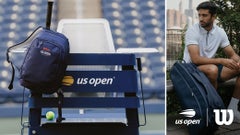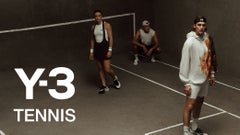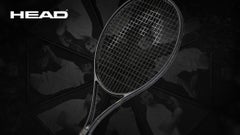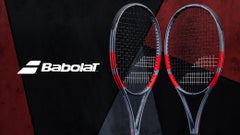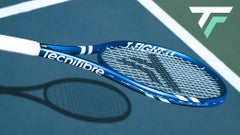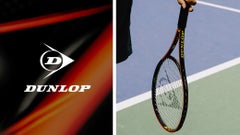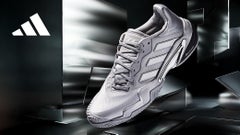Tecnifibre TFight 325 Dynacore Racquet Review
| Tecnifibre TFight 325 Dynacore Racquet Scores | |
|---|---|
| Power | 73 |
| Comfort | 65 |
| Touch/Feel | 82 |
| Serves | 79 |
| Groundstrokes | 80 |
| Returns | 75 |
| Slice | 83 |
| Topspin | 80 |
| Volleys | 77 |
| Overall | 70 |
Upsides
- Control
- Feel
Downsides
- Small sweetspot
- Low powered
Summary
With its unique 18x19 string pattern and sub-320 swingweight, the TFight 325 Dynacore offered our playtesters precision and maneuverability from all areas of the court. The fast and responsive feel helped us put the ball exactly where we intended, especially around the net. It was also fairly low-powered, so our testers could swing big without fear of hitting long. However, the tight string pattern and unique distribution of weight combined to produce a fairly small sweetspot that was difficult to find consistently. Off-center contact was a little jarring at times, and when it did occur our team felt the power really dropped off. We feel the TFight 325 Dynacore will appeal to more experienced players looking for a racquet with great control and low power.
Groundstrokes - 80
Our playtesters enjoyed the pinpoint precision of the TFight 325 Dynacore from the baseline, but the small and unforgiving sweetspot was difficult to find consistently. Troy explained, "My favorite part about this racquet was that I could take aggressive swings, and I could confidently hit near lines on my groundstrokes because of the good directional control. I was able to maneuver the TFight 325 with ease, and I still found good stability, which isn't always the case for a racquet with a sub-320 swingweight. The 18x19 string pattern provided a familiar feel to me because I'm used to a 95 square inch headsize with an 18x20 string pattern. The downside was that the sweetspot was smaller than I prefer, even compared to other similar headsize racquets. When I made contact outside of the very center of the stringbed it felt dead."
"I was able to play with good consistency with this racquet, but not much else," Chris offered. "Let me explain. I found the response of this racquet to be a bit inconsistent. When I hit low down in the stringbed the response was decently plush and lively. However, anything caught near the tip of the racquet tended to drop short and the response did not feel good. On the upside, all of those shots landed inside the court. On the downside, my opponent was often able to attack the short ball. We managed to improve the response of the TFight 325 Dynacore by stringing it low with a soft co-poly, and it also played great with some weight added to the 12 o'clock position of the hoop. In stock form I was left wanting more predictability, although one area of consistency was spin production. I had a good sense of how much spin I was getting on the ball, and that helped improve my targeting."
Michelle liked the precise feel but found it difficult to generate pace on her groundstrokes. She shared, "I appreciated the control of the 18x19 string pattern. I felt like I could really hit out and was getting rewarded with good depth. The downside of this control was I just never felt like I was generating enough power. I would attack the ball and think I was hitting a big ball, but PlaySight told me otherwise. I was a little disappointed that I couldn't hit a bigger forehand. I had to get creative, and often after hitting five balls in the corners of the court, I would have to hit a short drop shot and bring my opponents in to pass them or win the point another way. I did enjoy the overall feel of the TFight 325 and felt like it was easy to slice with, although the sweetspot seemed on the smaller side to me. We did add some weight to this racquet for a while to open up the sweetspot, which helped. I think with some modification I could get this racquet to be just a bit more powerful and more effective for my game, but in stock form I just needed a bit more plow through."
Echoing the others' sentiments was Andy, who said, "I liked the precision this racquet offered from the baseline. I generally knew where the ball was going off my strings and felt confident going for my targets. However, I never felt totally confident swinging big because I found the sweetspot to be very small and unforgiving. I really had to focus on centering the ball on the racquet every time. When I made contact off center the impact was jarring and the power dropped off dramatically. In addition, I never felt totally comfortable with the balance of this racquet, and I had trouble finding my timing and getting the racquet around my body in time for contact."

Volleys - 77
For the most part our testers had some nice success at net with the TFight 325 Dynacore and enjoyed the maneuverable, responsive feel and excellent control. "I think my favorite spot on the court with this racquet was at the net," praised Michelle. "I found this racquet to be stable and maneuverable, which allowed me to hit almost flawless volleys. I could carve out smart shots to keep me in the point even when balls were drilled straight into my body. Touch was also easy to access. Overall, I loved volleying with this racquet."
Andy had a similar opinion, although the small sweetspot was still apparent to him. He offered, "The TFight 325 Dynacore performed better for me at net than it did from the baseline. I liked the control this racquet offered, and I thought the feel was very good when going for more finesse-type shots. I had to focus on making contact inside the sweetspot more than I would've liked, but it was easier to do with a shorter swing."
Troy liked this racquet's fast feel when he got into trouble in the forecourt. He said, "This racquet provided good maneuverability when covering the net. Whenever I was stretched out and off balance I could flick my wrist with ease to get the ball back. When I found the sweetspot the feel was plush and I could place the ball wherever I wanted in the court. When I missed the sweetspot feel and depth were lacking."
Chris could never get his net game dialed in during this playtest. He critiqued, "I struggled to volley well with this racquet. I was dumping a lot of volleys into the net that should have found their target on the other side. When I did clear the net my volleys tended to drop a little short. The TFight 325 felt like it simply did not have enough mass in the hoop."
Serves - 79
It was a mixed bag of opinions when it came to serving with the TFight 325 Dynacore. Chris liked the control this racquet offered but ultimately didn't feel like the racquet added much to his serves. He said, "I was a tad down on power but decently accurate with this racquet on serves. Lower tensions and a little added weight fixed the issue. In stock form I had a tendency to leave serves hanging, and the big returners here at TW were eating them up. I was getting enough spin to help me get the ball down inside the box, but nothing exceptional."
Michelle had a similar experience. She said, "Similar to groundstrokes, I was hitting decent pace but was struggling to see the numbers that correlated with that perception. In all honesty, this racquet didn't do anything special for me when serving. It was perfectly adequate hitting flat, kick and slice serves, but I didn't feel like any of those serves were enhanced because of this racquet."
It was the way the weight was distributed throughout the frame that bothered Andy the most when serving. He offered, "My dislike of the balance of the racquet caused me to lose a bit of the control I loved on other shots. It never really allowed me to get completely dialed in when serving. Although I was able to access various paces and spins during my service games, I never felt great going for 'the big one.' "
On the other hand, Troy had more success serving than anywhere else on the court. He praised, "Serves were my favorite shot to hit with the TFight 325. I loved the pinpoint control and how easy it was to pronate my wrist. All my serves were working well, although I would have preferred a 16x19 string pattern to get a bit more action on slice and kick serves. I had great command of my first serves when going flat down-the-middle and was able to accelerate the racquet quickly to get good pace. I was able to clock 105 mph on my serve, just shy of my personal best (107 mph with the Babolat Pure Drive Tour Plus). The small sweetspot issue was negligible on serve."

Returns - 75
Control was the strength of the TFight 325 Dynacore on returns, but our players struggled with the unforgiving nature of this racquet. Andy said, "This racquet continued to feel unforgiving on returns, and I really had to focus on centering the ball. I prefer a racquet with a slightly larger sweetspot so I can feel more comfortable taking a bigger cut at the ball without fear of mis-hitting. Precision and feel were very good when I made good contact, but unfortunately, mere mortals can't do that every time."
The low-powered response helped control Michelle's power game. She shared, "I could really appreciate the extra control on returns the most. I have a tendency to get excited and attack a little too much, but the 18x19 string pattern may have saved me a few times. I wasn't missing too many returns and I was more consistent with this racquet. On the other hand, I felt like my attacking returns weren't as effective."
Chris liked taking big cuts at the ball but continued to find this racquet a tad unforgiving off-center. He said, "I was able to take a good swing at the ball with the TFight 325 Dynacore, and I had the best results when I did. A faster swing helped me get the racquet through the ball better and resulted in a more stable feel. I again had some comfort issues when hitting higher in the stringbed because the response was very firm and dead up there."
Troy struggled with his return game, saying, "More times than not I found less than favorable results on my serve returns. On most second serve returns I could take big rips at the ball and hit a deep return at my opponent's feet. When facing bigger servers I struggled to get solid contact in the relatively small sweetspot. During one session I switched between this racquet and the Wilson Pro Staff RF97 Autograph, and I was getting much easier depth with the RF97. I found good control and maneuverability with the TFight 325 Dynacore, but the lack of depth and plow through was not allowing me to feel confident when returning."
Overall - 70
Likes
Chris- "I wasn't enjoying the TFight 325 Dynacore in stock form. It felt much better for my game when it was customized with some weight at the top of the hoop."
Andy- "Very good precision and feel, especially on finesse-type shots."
Michelle- "Lots of control and great to volley with."
Troy- "The control from all areas of the court. This racquet was plush and well dampened when making contact in the sweetspot."
Dislikes
Chris- "The dead and uncomfortable response in the upper third of the hoop. I have zero desire to hit one of these again in stock form now that the test is over."
Andy- "The TFight 325 Dynacore has a small sweetspot, and if the ball hit outside of it this racquet felt jarring and unforgiving. The balance just felt a little off to me, too, and I could never get totally comfortable during the playtest."
Michelle- "The lack of power."
Troy- "The dead feel on off-center hits."
Comparing it to other racquets they've used, our testers said:
Chris- "I have always liked the TFight 325 racquets, but unfortunately that ends here. This racquet was a big departure from previous versions. I have always thought the previous TFight 325s went toe to toe with the likes of the Wilson Six.One 95 and Head Prestige Pros. For me, this racquet doesn't hold a candle to those or previous TFight 325s."
Andy- "The TFight 325 Dynacore felt similar to the Dunlop F2.0 Tour and Head Graphene Prestige Pro. Both of those have a stiffer, more modern feel while aiming to preserve the classic precision and feel of a traditional player's frame. However, I prefer the Head and Dunlop over this TFight because they felt slightly more forgiving and easier to maneuver."
Michelle- "The control and feel of this racquet reminded me a bit of the Babolat Pure Strike Tour. However, I felt like I could get more juice out of the Pure Strike Tour and could step up and put balls away, which was my main struggle with this racquet."
Troy- "I found some similarities to the Six.One 95 (18x20), but this racquet was less forgiving and didn't quite pack the punch of the Six.One. Some other racquets that come to mind are the Volkl Organix 10 (325), Dunlop Aerogel 200, and Head YOUTEK IG Prestige MP."
|
|
||||||||||||||||||||||||||||||||||||
Scores
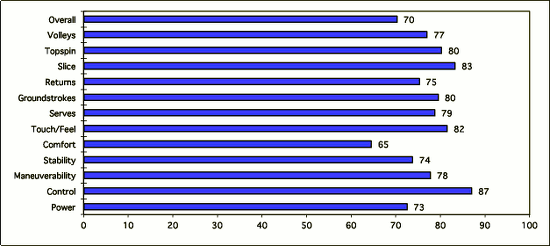
(Scores are determined by averaging individual play test scores)
| Chris' Scores | |||
|---|---|---|---|
| Power | 8.3 | Serves | 7.5 |
| Control | 8.3 | Groundstrokes | 8 |
| Maneuverability | 7.8 | Returns | 8 |
| Stability | 7.7 | Slice | 8.3 |
| Comfort | 4.8 | Topspin | 8 |
| Touch/Feel | 7 | Volleys | 6.8 |
| Overall | 6 | ||
| Andy's Scores | |||
|---|---|---|---|
| Power | 7 | Serves | 7 |
| Control | 8.5 | Groundstrokes | 7 |
| Maneuverability | 7 | Returns | 7 |
| Stability | 6 | Slice | 8 |
| Comfort | 5 | Topspin | 7.5 |
| Touch/Feel | 8.5 | Volleys | 7.5 |
| Overall | 6.2 | ||
| Michelle's Scores | |||
|---|---|---|---|
| Power | 7 | Serves | 8 |
| Control | 8.8 | Groundstrokes | 8.3 |
| Maneuverability | 8 | Returns | 8.6 |
| Stability | 7.8 | Slice | 8.5 |
| Comfort | 8 | Topspin | 8.6 |
| Touch/Feel | 8.5 | Volleys | 8.8 |
| Overall | 7.8 | ||
| Troy's Scores | |||
|---|---|---|---|
| Power | 6.7 | Serves | 9 |
| Control | 9.2 | Groundstrokes | 8.5 |
| Maneuverability | 8.3 | Returns | 6.5 |
| Stability | 8 | Slice | 8.5 |
| Comfort | 8 | Topspin | 8 |
| Touch/Feel | 8.6 | Volleys | 7.7 |
| Overall | 8.1 | ||
Playtester Profiles
Chris: 5.0 all-court player currently using the Wilson Six.One 95S. Chris uses a full-western forehand grip, has a fast swing style and hits a one-handed backhand.
Andy: Open level all court player with a semi-western forehand grip and a two handed backhand. Andy currently using a Yonex EZONE Ai 98.
Michelle: Open level baseline player with a semi-western forehand and a two handed backhand. She currently plays with the Wilson Pro Staff RF 97 Autograph.
Troy: 5.0 lefty all-court player with a full Western Forehand and a two-handed backhand. Troy currently plays with a Wilson BLX Six.One 95.
Review date: March 2015. If you found this review interesting or have further questions or comments please contact us.
All content copyright 2015 Tennis Warehouse.




